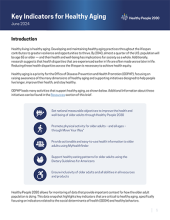Healthy People 2030 sets measurable national objectives with 10-year targets to improve the health and well-being of all people. Twenty of those objectives are specifically focused on reducing health problems and improving quality of life for older adults. Healthy People 2030’s population data make it easy to see how older adults’ health compares to national targets.
Use the Healthy People 2030 older adults objectives to:
- Set your own targets for your programs
- Find practical tools, including evidence-based resources your community, state, or organization can use
- Monitor national progress – and use our data as a benchmark
ODPHP has curated a set of objectives from Healthy People 2030 that are directly or indirectly related to healthy aging into a custom list so they're easy for you to reference and track.
Access data for older adults
For many Healthy People 2030 objectives, data are available by age group.* Follow these steps to access data for older adults:
- Navigate to the Objective Overview page for a specific objective
- Click the Data tab in the left-hand menu or the “See detailed data for this objective” button
- In the Demographic Group drop-down menu in either the Data Table or Data Chart tab, select “Age group”
- Click “Show Data” to see data for different age groups — including adults age 65 years and older if data are available for this group
*Some objectives don’t have age group data yet, but check back periodically. We’ll add age group data when they’re available.
Key Indicators for Healthy Aging
This data snapshot highlights Healthy People 2030 Objectives that are critical to healthy aging, specifically focusing on the social determinants of health and important health behaviors — like physical activity and healthy eating.

Find evidence-based resources to use in your work
Evidence-based resources (EBRs) are published reviews of studies and interventions to improve health. And Healthy People 2030 includes many EBRs that are specifically related to older adults and healthy aging. These EBRs are helpful for planning and implementing programs and policies, writing grants, providing clinical guidance, conducting research, or teaching people about healthy aging.
You can access EBRs that are relevant to a specific objective from its Objective Overview or Data page. Just click the Evidence-Based Resources tab in the left-hand menu.
You can also browse a list of EBRs that are related to older adults more generally.
Social Determinants of Health and Older Adults
Social Determinants of Health have a big impact on our chances of staying healthy as we age. Healthy People’s actionable scenarios highlight ways professionals can support older adults’ health and well-being.
Sample scenario
A project manager at an agency that promotes health for older adults is working on a falls prevention program. Here’s how they might use Healthy People 2030’s tools and resources:
- They check out the Older Adults page and find this objective: Reduce fall-related deaths among older adults — IVP-08.
- After navigating to the data for the objective, they see that the objective’s status is “Getting worse.” They plan to cite this data and use it as rationale in applications for grant funding.
- Next they browse EBRs related to the objective and find a guide on implementing community-based falls prevention programs. They share the guide with their team, who will use it to plan a local falls prevention program.
- Then they look at the Healthy Aging Custom List to find other relevant objectives. They see this one: Increase the proportion of homes that have an entrance without steps — DH-04. They note that the objective’s national target has been met or exceeded — but their agency also has local data showing that entrances without steps are common in their community. Using local data as a baseline and national data as a benchmark, they set their own goals for improving this issue at the community level.
